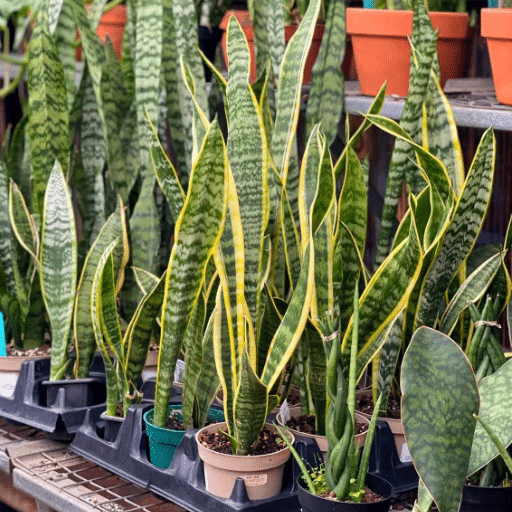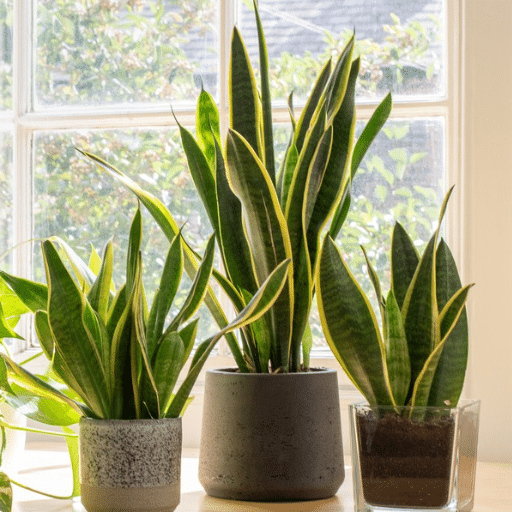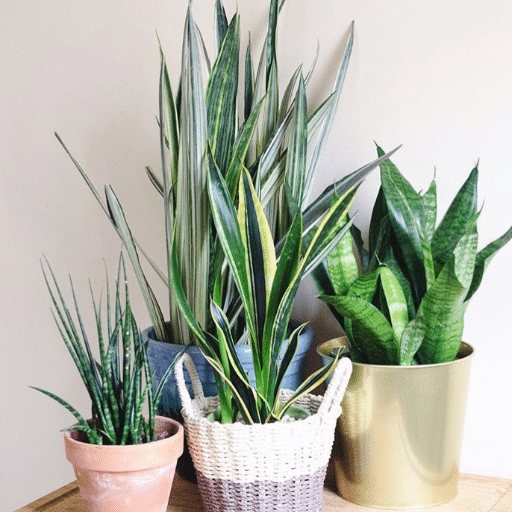One of the adored tough plants with a pretty appearance is the snake plant, or Sansevieria. This blog post will give you all the snake plant grow guide care tips so you can ensure it will thrive. You will learn all about lighting needs, watering schedule, type of soil, appropriate temperature, and even propagation techniques. This guide gives all the information you will need to produce a strong and vibrant snake plant, whether you are a new plant parent adding this versatile plant to your already-growing collection or a seasoned enthusiast.
Introduction to Snake Plant Care

Snake plants go by various names, Sansevieria and Dracaena trifasciata amongst them, and are widely known for their hardworking nature and aesthetic appeal, which has paved the way for popularity amongst plant enthusiasts. Snake plants like bright, indirect light, but they will tolerate less if that is what you provide for them. Moderate watering is required; let the potting mix dry out completely in between waterings or else root rot sets in. They like to grow in well-drained soils such as cactus soils, at temperatures ranging from 60 to 80°F (15 to 27°C). Lastly, they are easy to propagate by way of leaf cuttings or division, and this makes for an enjoyable and resilient plant in any indoor space.
What is a Snake Plant?
A snake plant, or Sansevieria or Dracaena trifasciata, is a commonly found houseplant with very little maintenance and is famous for its upright sword-like leaves, along with its air-purifying effects. I love how rebellious it is and adaptable to different conditions as well as light; it can grow under bright indirect light or, sometimes, even low light. Its drought tolerance makes it just the right plant for people with busy lifestyles. It only needs to be watered when the soil has dried completely. It is also an excellent air purifier in that it can filter toxins from the air, as some studies claim.
Benefits of Growing Snake Plants Indoors
Above all, snake plants are probably the best indoor plants for enhancing air quality in the house. I appreciate what they do in actively filtering harmful toxins such as formaldehyde and benzene so that my living environment is cleaner and healthier. Furthermore, they require very little maintenance, which fits well with my busy schedule. They are tolerant of an array of light conditions, meaning I can virtually place them anywhere in my home without worrying about sunlight requirements. Their aesthetic appeal is another plus; I just love how those slick, upright leaves bring a bit of class into the room. In summary, snake plants represent the perfect blend of practicality mixed with elegance, making them as one of my favorite plants for indoors.
Overview of Care for a Snake Plant
The care of a snake plant is very simple and rewarding. My method of watering involves doing so sparingly every two or three weeks, only after the soil is entirely dry. Overwatering is the root cause of rot so I never want to do that to my plant. For lighting, snakes like to adapt; discriminatively, I highly prefer bright, indirect sunlight, but it thrive in low light as well. For soil, I choose a well-draining potting mix, mostly one meant for succulents. Sometimes, about once every month during the growing season, I fertilize with an all-purpose houseplant feed. I try to avoid putting the plant in drafty conditions or where the temperature drops below 50 degrees Fahrenheit. These are my basic premises that keep my snake plant in good health and thriving.
Essential Care Tips for Snake Plants

Snake plants do well generally in indirect sunlight but can thrive in low-light environments; hence, these plants fit into a variety of interiors. Use well-draining soil, preferably designed for succulent potting, as this can prevent rotting. Water only when the soil is totally dry, as excess water is bad for the plant. Fertilize once a month with a general-purpose fertilizer for indoor plants while the plant is growing. Keep the plant away from drafts and maintain a temperature above 50°F, so it will not be stressed. Simple things like these are all you need to keep your plant flourishing with minimal care.
Choosing the Right Pot for Your Snake Plant
Whenever selecting the right pot for your snake plant, I always see to it that there are drainage holes at the bottom–to allow the runoff of excess water that might have stayed indefinitely in the soil, thus causing root rot. Terracotta is a good material because it is porous and keeps moisture in check; plastic pots are not a bad second choice if you do pay attention to when and how much you water. Also, ensure that the pot is just right in size–a good guideline would be 1 to 2 inches wider than the root ball to allow for a little room to grow but not so much as to drown the plant. Lastly, do not go for extra-large pots; it will keep the potting mix too moist, and that is not beneficial for snake plants.
Watering Requirements for Sansevieria
When I water Sansevieria, I make sure the soil dries out completely between waterings. Overwatering is among the worst mistakes for this plant, so I gauge the dryness by checking the soil with a finger an inch deep; if it is dry, I water thoroughly and let all excess water drain out. During spring and summer, I water every two or three weeks, depending on humidity and light; in fall and winter, however, I decrease watering to once a month or even less because of the slowed growth rate. This schedule keeps my Sansevieria healthy and happy.
Best Potting Mix for Snake Plants
When considering the best potting mix for snake plants, I prefer well-draining soil that caters to their natural requirements. A mixture of succulent or cactus soil and perlite is an excellent choice because it prevents the accumulation of water around the roots, which could otherwise cause them to rot. When I do not find these mixes available, I prefer making my own using a ratio of 2 parts potting soil, 1 part sand, and 1 part perlite. Basically, keep the mix loose and airy. That provides proper airflow and quick drainage, good for snake plants to keep their health.
Growing Snake Plants Successfully

Snake plants can survive in the hardest conditions, but really need appropriate watering and light conditions to thrive. They like to dry between watered sessions, so make sure your soil has completely dried out prior to watering again- a frequent mistake made by gardeners is overwatering their snake plants, which oftentimes will lead to root rot. Light-wise, snake plants can take it from dark corners to a bright, open window, but they grow fastest in bright, indirect light. Balancing these requirements and not overwatering will keep the plant healthy and vibrant.
Optimal Light Conditions for Snake Plant Growth
From my personal experience and research, snake plants are adaptable but prefer bright light without direct sun. They don’t mind lower light spots, like a dimly lit hallway, or some direct sun, but long exposure to harsh afternoon sun can cause the leaves to burn. If quicker growth is desired, find a room with good light and subject the snake plant to filtered sunlight. When considering the health of the plant, rotation every once in a while is good so that it receives equal light on all sides. Remember, their resilience provides some leeway, but extra care in lighting will make them really shine.
Temperature and Humidity Preferences
The snake plants can thrive over a fairly broad temperature range, but would ideally like to maintain the temperature somewhere in between 60°F and 80°F. Temperature as low as 50°F would be tolerable, but they need a little protection against sudden cold drafts or frost as it may harm the plants. They are good at cleaning the average humidity level of a house, but sometimes they don’t mind if it’s a bit drier or a bit more humid. For growth purposes, a stable temperature and humidity level, without stark fluctuations in moisture or temperature, would be desirable. Consistent care will reward you with a snake plant sporting lavish foliage.
Common Pests and How to Manage Them
According to my knowledge, snake plants are basically hardy, but sometimes, pest problems set in, with mealybugs, spider mites, and scale insects commonly found. Mealybugs will show up as white, cotton-like spots on the leaf surface. Conversely, spider mites tend to leave tiny webs and discolored speckled patches. Scale insects are those small, brownish bumps adhering to the plant surface.
My method of pest control is gently wiping the leaves with a cotton swab dipped in rubbing alcohol, as this usually kills or removes almost all pests. For overwhelmed situations, insecticidal soap or neem oil spray is most effective, making sure to spray both sides of the leaves. Prevent future outbreaks by inspecting your plant regularly and maintaining good air circulation, avoiding overwatering since it attracts these pests. With care, most pest problems will in all likelihood, remain in check.
Repotting and Propagating Snake Plants

Repotting is required when the roots outgrow the pot, which occurs every two to three years in most cases. The ideal pot is only slightly larger than the existing one and has adequate drainage to permit any excess moisture to drain through. Use a well-draining potting mix as excess moisture will harm the roots. Propagating is really straightforward with division you split the plant up into smaller clumps at the root base gently, you can replant them with ease. Leaf cuttings are another option-either cut leaf sections 2-3 inches long from a healthy leaf or insert the cuttings in moist soil or water until the roots develop. Both methods can straightforwardly aid in the creation of healthy new plants.
When to Repot Your Snake Plant
Repotting your snake plant is usually needed every two to three years or when you notice its roots start to outgrow the current pot. I check for typical signs like roots emerging through the drainage holes, soil drying out instantly, or the plant looking a bit top-heavy. While repotting, I use a pot just one step up from what it has now, and with very good drainage properties so the roots wouldn’t rot. Spring is the best time because the plant is getting into its active growth phase and is better able to adjust to its new home.
How to Propagate Snake Plants
Propagation of snake plants is easy and I do it mainly in two ways-leaf cuttings and division. For leaf cuttings, I take a healthy leaf and cut it into sections. Then I allow the cuttings to dry for about an hour to prevent rot. After that, I put the cuttings in water or well-draining soil, making sure to plant the right end. For divisions, I gently remove the plant from its pot and carefully separate the clumps, ensuring each section contains a healthy rhizome and healthy roots before replanting. Both methods work well for me, although division is usually faster.
Tips for Successful Propagation
Choose Healthy Parent Plants: Always start with a robust and disease-free parent plant. The healthier the source, the higher the chance of successful propagation. Inspect leaves and roots carefully before proceeding.
Use Clean Tools and Containers: Sterilize your scissors, knives, or pruning shears before making cuts to avoid the spread of bacteria or fungus that might harm the cuttings.
Provide the Right Environment: Ensure your cuttings have the proper conditions to thrive-well-draining soil or water, adequate humidity, and indirect light. Keeping the temperature consistent can also accelerate root growth.
Patience is Key: Propagation takes time. Monitor moisture levels carefully to avoid overwatering, which could lead to rot, but do not allow the medium to dry out completely.
Track Your Success: Keeping a journal or taking notes about your propagation attempts-such as the method, plant type, and environment, help refine your technique over time to achieve optimal results.
In following these steps, I find my propagation success goes through the roof, giving me a shop of thriving plants-anywhere!
Conclusion: Mastering Snake Plant Grow Guide

Caring for a snake plant in the best way possible means striking the right balance among light, watering, and soil. They enjoy indirect light, watered sparingly to discourage rotting of the roots, and planted with permeable soil so that they will do well just about anywhere. Keeping their leaves clean and repotting them occasionally will only benefit their health. Propagating is an easy task, which, if done with patience and care, offers bigger rewards in giving you more plants to add to your collection or share among friends. These suggestions will make snake plant care very easy and rewarding.
Final Thoughts on Growing and Caring for Snake Plants
The snake plant is pretty sturdy and pretty to look at, and suitable for amateurs and seasoned plant enthusiasts. Giving it bright, indirect light with occasional watering when the soil gets dry is what guarantees its survival. Well-draining soil is a must, so root rot is prevented; some fertilization during the growing season will do it good. Its leaves need cleaning regularly so that dust and pests don’t settle and repotting as it grows. Propagation is quite straightforward and richly rewarding as it serves as a way to increase your stock or share with a friend! These simple tips will make sure you enjoy the perennial beauty and benefits of snake plants wherever you place them.
Resources for Further Learning
Here are some fine resources to inspire and broaden your understanding of snake plant care. For more detailed guides, check out famous gardening sites like the USDA Plant Hardiness Zone Map or The Old Farmer’s Almanac, where specialized advice is given depending on your respective region. Channels like Planterina or Epic Gardening on YouTube have an arsenal of step-by-step tutorials for beginners and pros alike. Should books be your cherished choice, “The Complete Houseplant Survival Manual” by Barbara Pleasant will never disappoint. Local gardening centers or nurseries are exquisite places to ask questions and stay fresh on tips from the pros. Such tools and guidance will put in you a working knowledge of snake plants.
Join the Community of Snake Plant Enthusiasts
Joining the community of snake plant enthusiasts has been so rewarding for me. When I started, I relied on Planterina and Epic Gardening on YouTube for easy-to-follow instructions, and I highly recommend their tutorials to anyone. I also leaned on The Complete Houseplant Survival Manual for more nuanced questions about light, water, and repotting. Visiting local nurseries and chatting with plant experts has been invaluable in the moment, supplying me with much-needed tips and encouragement to expand. Using resources like the above and connecting with other enthusiasts truly has enabled me to care for my snake plants confidently and joyfully!
References
-
The Spruce: Snake Plant: Care & Growing Guide – This guide covers essential care tips, including sunlight requirements and general maintenance.
-
Joy Us Garden: Snake Plant Care: How to Grow this Diehard Houseplant – Offers detailed advice on soil mix, potting, and drainage for snake plants.
-
Patch Plants: Complete guide to snake plant care – Provides insights on sunlight, temperature, and repotting needs for snake plants.
Frequently Asked Questions (FAQ)
What type of snake plant is best for beginners?
One of the easiest plants to care for is the snake plant, also known as Sansevieria. The most common type for beginners is the Dracaena trifasciata, which has tall leaves that can grow up to 4′ tall. This plant thrives in a range of lighting conditions, making it adaptable for indoor environments. Additionally, it prefers low light and dry conditions, so it’s perfect for those who may forget to water their plants often. With minimal care, this succulent plant can flourish in your home.
How much water do my snake plants need?
Snake plants don’t require much water, making them ideal for those who are new to plant care. It’s essential to wait until the soil is dry before watering your snake plant. Overwatering can kill a snake plant, so it’s crucial to ensure that the potting mix allows for proper drainage. Generally, watering every 2-6 weeks, depending on the season and humidity, is sufficient. Remember to check the bottom of the pot for any excess water to prevent root rot.
Can I propagate my snake plant?
Yes, you can easily propagate your snake plant using leaf cuttings or by dividing the original plant. Propagating snake plants is a straightforward process, and they grow well in fresh soil. When propagating, ensure that you allow the cuttings to callous over for a few days before placing them in potting mix. This helps prevent rot. Keep the new snake plant in indirect light until it establishes roots, and soon you’ll see new growth.
When should I repot my snake plant?
A snake plant needs repotting when it becomes pot-bound, typically every 2-3 years. Signs that it’s time to repot include roots growing out of the drainage holes or if the plant isn’t growing as vigorously as before. When repotting, choose a new pot that is only slightly larger than the current one to avoid overwhelming the plant. Use a well-draining potting mix suitable for succulent plants to keep the roots healthy. After repotting, water your snake plant lightly and allow it to acclimate to its new environment.
What are some care tips for keeping my snake plant healthy?
To ensure that your snake plant is looking its best, provide it with bright, indirect light and avoid direct sunlight, which can scorch the leaves. Water your snake plant only when the soil is dry, and be cautious not to overfertilize it. Using a balanced liquid fertilizer during the growing season can promote healthy growth. Additionally, regularly dust the leaves to allow the plant to absorb more light. Pruning any dead or damaged leaves can also help maintain the health of the plant.
How do I know if my snake plant is thriving?
A thriving snake plant will display vibrant, upright leaves that are firm to the touch. If your plant is actively growing, you may notice new leaves appearing on tall spikes. Healthy snake plants also maintain their color and do not show signs of wilting or yellowing. If you see that your plant is producing new growth and staying upright, it’s a good indicator that it’s happy and thriving in its environment. Regularly check for pests or signs of distress to keep your plant healthy.









